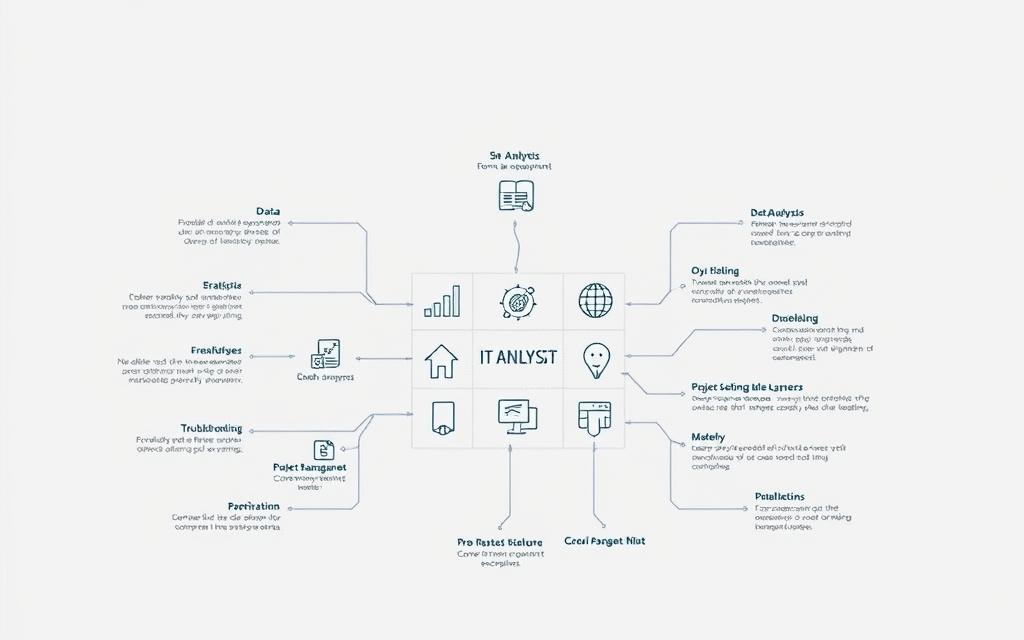In today’s digitally driven workplaces, an IT analyst is key to efficient information systems management. They link technical skills with business goals, creating systems that help companies stay ahead. In the US, they earn around $120,000 (£94,000) a year, with a 15% growth expected in the field.
IT analysts focus on making systems better and supporting operations. They deal with network problems and set up security measures. These tasks are vital, as shown by the Bureau of Labor Statistics.
Many start in help desk roles before moving to special areas like cloud computing or data management. Their work is essential in healthcare and finance, where digital systems are critical.
Defining the Information Technology Analyst Role
Today’s businesses need IT analysts to turn complex tech needs into clear business plans. They connect executives with developers, making sure tech investments help the company grow. Their work is key to keeping the business ahead of the competition.
Core purpose in modern organisations
IT analysts link tech teams with non-tech people. They check current systems and find ways to make things better. A typical week might include:
- Turning department needs into software plans
- Looking at new tech to see if it fits the business
- Creating plans to show if new IT is worth the cost
“The best IT analysts speak both boardroom and server-room languages fluently. They’re the Rosetta Stone of enterprise technology.”
Difference between IT analysts and related roles
IT analysts and systems analysts are often mixed up, but they’re not the same. IT analysts look at the big picture, while systems analysts focus on specific systems. Here’s how they differ:
| Role | Focus Area | Key Responsibility |
|---|---|---|
| IT Analyst | Enterprise-wide alignment | Strategic technology planning |
| Systems Analyst | Specific software systems | System optimisation |
| Software Engineer | Technical implementation | Code development |
The systems analyst vs IT analyst comparison shows big differences. Systems analysts work on one app at a time, while IT analysts look at how systems work together. This wider view helps them bring new ideas to different fields, like healthcare and retail.
Key Responsibilities of IT Analysts
IT analysts play a vital role in digital operations. They ensure systems run smoothly and align with business goals. Their work includes technical checks, risk reduction, and team collaboration. These efforts help companies stay ahead in the data world.

Systems Evaluation and Optimisation
IT analysts regularly check systems using tools like JIRA. They focus on:
- User Acceptance Testing (UAT) validation
- Infrastructure scalability assessments
- Post-implementation support protocols
This cycle keeps systems up-to-date and cost-effective for businesses.
Business Process Alignment Strategies
Analysts use IT gap analysis to find where systems and goals don’t match. They use:
- Tableau dashboards for real-time process visualisation
- Cross-departmental requirement workshops
- ROI calculation frameworks
These tools help focus IT spending on real improvements.
Cybersecurity Monitoring Protocols
Analysts fight cyber threats with strong defence strategies. They use:
- Automated compliance auditing via Splunk
- Real-time intrusion detection systems
- Quarterly penetration testing
This approach lowers risks and meets important data protection laws.
Stakeholder Communication Frameworks
Analysts explain technical details in business terms. They use:
- Visual system lifecycle management roadmaps
- Non-technical KPI reporting
- Agile sprint review sessions
They keep everyone informed, ensuring IT plans match company goals.
Essential Technical Skills for Success
Being great at IT analysis means knowing the core technical skills. These skills help IT analysts link what the company wants with what technology can do. They need to be good at three main areas.
Data Analysis Tools Proficiency
Today’s IT analysts use database optimisation and business intelligence tools to make decisions. They need to know both basic and advanced tools well.
SQL and Database Management
SQL is key for working with data. Tools like PostgreSQL help analysts:
- Build efficient databases
- Join data from different tables
- Make queries run fast with big data
Experts often use Python’s Pandas with SQL for complex data transformation pipelines. This is useful when working with cloud storage.
Business Intelligence Platforms
Tools like Tableau and Microsoft Power BI turn data into insights. They help by:
- Creating interactive dashboards
- Tracking KPIs in real-time
- Doing predictive analytics
“The true power of BI lies in making complex datasets accessible to non-technical decision-makers.”
Network Infrastructure Knowledge
With 78% of companies using cloud infrastructure (AWS/Azure), IT analysts need to know:
- How to set up virtual private clouds
- Network segmentation strategies
- How to keep data safe during transmission
Tools like Wireshark and Nmap are key. Many companies look for candidates with Cisco CCNA certification for these roles.
Programming Fundamentals
While not needing to be full-stack developers, knowing scripting languages is very helpful:
Python for Automation Tasks
Python is great for making:
- Scripts to clean data
- API integrations
- Automated reports
JavaScript for System Interfaces
Knowing basic JavaScript helps analysts work well with developers. They can help with:
- Prototyping user interfaces
- Checking form data
- Making dashboards more interactive
This knowledge lets analysts suggest real solutions in meetings.
Critical Soft Skills Development
Technical skills are key in IT analysis, but soft skills are what really make a difference. They help analysts turn complex data into useful plans. They also make sure technical teams and business leaders work well together.

Problem-Solving Methodologies
IT analysts use methods like root cause analysis and scenario modelling to fix problems. They follow a set of steps:
- They start by clearly defining the problem with numbers.
- They use ER diagrams to show how things work and manage stakeholders.
- They test solutions in safe environments.
For example, fixing slow database issues might mean working with developers. They test how the system handles lots of traffic. Then, they explain the results to people who don’t know tech.
Cross-Departmental Collaboration Techniques
Working well with others is key in team projects. Analysts need to:
| Department | Communication Tool | Conflict Resolution Tactic |
|---|---|---|
| Development | Jira integrations | Sprint retrospectives |
| Executive | Visual dashboards | ROI-focused language |
| Vendor Management | Slack channels | Service-level agreement reviews |
This way, everyone gets the same information. It’s very helpful when making big changes like updating security or moving to the cloud.
Technical Documentation Best Practices
Good documentation is clear and easy to read. Confluence templates have:
- Headers with version control and approval signs
- Interactive flowcharts to explain system architecture
- Glossaries to explain tech terms for non-tech teams
Analysts also use screenshot annotations and video walkthroughs to help. This makes it 37% faster to get new team members up to speed, according to surveys.
Educational Pathways and Requirements
To become an IT analyst, you need to plan your education and skills carefully. 90% of professionals in the field hold degrees, says Glassdoor. But, there are also other ways like certifications and experience that are becoming more popular, mainly for those changing careers.
Degree Programmes in Computer Science
A BSc Computer Science degree is often the first step. It teaches you about algorithms, database management, and systems architecture. Universities now offer specialisations in business analytics and cybersecurity, matching what employers want. For quicker paths:
| Pathway | Duration | Key Advantage |
|---|---|---|
| Traditional Degree | 3-4 years | Comprehensive theory |
| Coding Bootcamps | 3-6 months | Practical skill focus |
| Online Programmes | Self-paced | Flexibility |
Specialised IT Analysis Certifications
Certifications fill skill gaps and prove your skills. The CISSP certification is key for cybersecurity, while CompTIA Security+ is more general. Vendor-specific qualifications like AWS Certified Solutions Architect are also getting more attention:
“Employers now value certifications that show you can work with cloud technologies and traditional security knowledge.”
Experience Equivalency Considerations
Many employers accept 3+ years of relevant work experience instead of a degree for certain roles. Career transition strategies often include:
- Completing project-based freelance work
- Demonstrating open-source contributions
- Showcasing cross-functional team leadership
Combining certifications with building a portfolio works well for those not following traditional paths. As hiring methods change, keeping up with learning is key, no matter your starting point.
Industry-Specific Applications
Information technology analysts add great value to specific sectors. They create solutions that meet industry needs. Their skills help with technical, regulatory, and operational aspects in healthcare, finance, and retail.

Healthcare Systems Integration
In healthcare, IT analysts work on integrating electronic health records (EHR). They make sure these systems follow HIPAA compliance. Epic Systems’ platforms are a good example, allowing safe data sharing between hospitals and clinics.
They face challenges like:
- Ensuring encrypted patient data transmission
- Automating appointment scheduling workflows
- Auditing access logs for regulatory reporting
A 2022 study by the Centre for the Study of Living found that healthcare organisations with integrated systems cut administrative costs by 18%.
Financial Services Compliance Analysis
Banking institutions need IT analysts to set up fintech solutions that follow Financial Conduct Authority (FCA) rules. Splunk’s tools help track:
- Real-time transaction anomalies
- Anti-money laundering (AML) pattern detection
- Data breach response protocols
This method cut false positive alerts by 42% in US banks last year, as reported by fintech security reports.
Retail Supply Chain Optimisation
Modern inventory management systems use RFID technology to change retail operations. Analysts set up these systems to:
- Track stock levels across 500+ stores in real time
- Predict seasonal demand using AI algorithms
- Automate reorder processes for high-turnover items
Big retailers see 27% fewer stockouts and 15% lower warehousing costs after using these solutions.
Career Progression Opportunities
IT analysts have many paths to grow in their careers. They can move from technical roles to leadership positions. Salaries can increase from £73k for technical jobs to £119k for leadership roles.

Climbing the Seniority Ladder
To become a senior analyst, you need:
- 3-5 years of experience in systems optimisation
- Certifications like CompTIA Security+ or AWS Solutions Architect
- Success in projects that involve different departments
Shifting to Leadership Roles
For IT leadership development, you’ll need PMP certification and team management skills. Here’s how salaries can increase:
| Position | Key Skills | Average Salary |
|---|---|---|
| Technical Analyst | Data tools, network protocols | £73k |
| IT Manager | Budgeting, stakeholder alignment | £97k |
| Director of IT | Strategic planning, CISO career path knowledge | £119k |
Building Consultancy Expertise
The technical consultancy path is strong in firms like Deloitte or PwC. Here, experts:
- Help with digital transformation projects
- Need CISA certifications for audit roles
- Can earn over £600 a day in cybersecurity
“Consultancy demand for IT analysts will grow 28% by 2026, mainly in financial compliance and healthcare systems integration.”
IT professionals should keep updating their skills. This is key for both specialist roles and management positions.
Positioning for Success in Evolving Tech Landscapes
IT analysts are becoming more valuable as companies move faster towards digital change. The US Bureau of Labor Statistics says computer systems analysts will grow by 9% by 2032. This means those with the right skills are in high demand.
To stay ahead, IT analysts need to plan their careers well. Getting certifications like the Google IT Support Professional Certificate on Coursera is key. Adding real-world experience in areas like cybersecurity or data visualisation makes a strong candidate.
Those who do well in digital transformation keep learning and adapting. Staying up-to-date with AI and cloud migration is important. Using resources like CompTIA’s IT Career Roadmap helps match skills with job needs. IT analysis is a field that offers many chances to shape technology in different industries.







